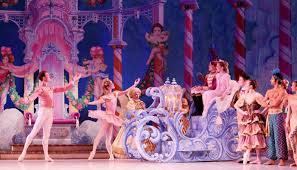 I spent the weekend in the orchestra pit. The Richmond Symphony accompanied Richmond Ballet in five performances of Sergei Prokofiev’s Cinderella. Written between 1940 and 1944, Prokofiev’s lushly romantic and virtuosic score captures perfectly the drama and atmosphere of the famous fairy tale story.
I spent the weekend in the orchestra pit. The Richmond Symphony accompanied Richmond Ballet in five performances of Sergei Prokofiev’s Cinderella. Written between 1940 and 1944, Prokofiev’s lushly romantic and virtuosic score captures perfectly the drama and atmosphere of the famous fairy tale story.
Here is what Prokofiev said about the score:
[quote]What I wished to express above all in the music of Cinderella was the poetic love of Cinderella and the Prince, the birth and flowering of that love, the obstacles in its path, and finally the dream fulfilled. The fairytale offered a number of fascinating problems for me as a composer – the atmosphere of magic surrounding the Fairy Godmother, the twelve fantastic dwarves that pop out of the clock as it strikes twelve and dance chechotka reminding Cinderella that she must return home; the swift change of scene as the Prince journeys far and wide in search of Cinderella; the poetry of nature personified by the four fairies symbolizing the four seasons…[/quote]
Cinderella is full of quirky and slightly sarcastic melodies which play with our expectations. Prokofiev loves to give us little musical curve balls in the form of “wrong” notes and sudden harmonic twists. More than once he veers off into a completely unrelated key. Here are some highlights from the score:
[typography font=”Cantarell” size=”28″ size_format=”px”]Going to the Ball[/typography]
In this first excerpt, can you hear Cinderella’s sense of breathless excitement and anticipation? How does Prokofiev’s music capture this mood? After 1:08 notice the way the music alternates between a feeling of two (walking) and a feeling of three (an elegant waltz).
[typography font=”Cantarell” size=”28″ size_format=”px”]Cinderella’s Waltz and Midnight[/typography]
Here is the end of the second act. Following the famous waltz, the clock strikes midnight (2:49). Listen to the way the music captures the drama of this critical moment in the story:
[typography font=”Cantarell” size=”28″ size_format=”px”]Amoroso[/typography]
Do you remember the theme you heard at the end of the last excerpt? This theme is first introduced at the beginning of the ballet. Representing the love between Cinderella and the Prince, it functions as musical foreshadowing. At the end of the ballet, as Cinderella dances with the prince, the theme returns. Prokofiev creates a feeling of depth and soaring expansiveness in the orchestration. Listen to the wide range between the lowest and highest instruments right up to the final chords as the curtain falls:
[button link=”https://itunes.apple.com/nz/album/prokofiev-cinderella/id509355975″]Find on iTunes[/button] [button link=”https://itunes.apple.com/nz/album/prokofiev-cinderella/id509355975″]Find on Amazon[/button]

 Nutcracker season is in full swing here in Richmond. My orchestra, the Richmond Symphony, will perform Tchaikovsky’s Nutcracker thirteen times through December 23. Richmond Ballet’s long-term dedication to live music in the orchestra pit is commendable and elevates their already excellent productions. There is no replacement for the power and emotional punch of live music. Canned music has a “deadening” effect, while live music unleashes a creative energy which propels all other aspects of the production.
Nutcracker season is in full swing here in Richmond. My orchestra, the Richmond Symphony, will perform Tchaikovsky’s Nutcracker thirteen times through December 23. Richmond Ballet’s long-term dedication to live music in the orchestra pit is commendable and elevates their already excellent productions. There is no replacement for the power and emotional punch of live music. Canned music has a “deadening” effect, while live music unleashes a creative energy which propels all other aspects of the production.